You are using an out of date browser. It may not display this or other websites correctly.
You should upgrade or use an alternative browser.
You should upgrade or use an alternative browser.
Imprinting
- Thread starter Ellesan
- Start date

Help Support Miniature Horse Talk Forums:
This site may earn a commission from merchant affiliate
links, including eBay, Amazon, and others.
Rocklone Miniature Horses
past member -I gotta get a life...
Not done it all yet, but in my head, my plan is to halter at a few days old and just do it once every few days to make sure they are okay with it and have them walk about after mom on a lead. but in general not do too much. I will not, and don't feel comfortable with, them being taken away out of sight at any time until weaning and even at that i would prefer a wean that include mom being on the other side of a fence for a while.
This could all change as soon as it comes! lol
This could all change as soon as it comes! lol
amysue
Well-Known Member
Most of my broodmares are good about letting us handle their foals so we check them over soon after birth, dipping the navel, sometimes towel drying them if necessary. I handle them every day and I find that it really makes a difference. I run my hands all over their body, gently stick my fingers in their ears, look at their teeth, pick up their feet and get them used to grooming and being touched. Haltering and leading depends on the foal, some follow their dam around well while others take off the first chance they get so I do what works best for each individual one. I find it easier for us to teach them the concept of leading by first letting them follow their dam while on the lead, sometimes we will halter the foal, lead momma away then walk the foal on the lead back to her to get them used to leading. The older they get, the farther away we can walk them and the longer time they can spend away from momma. If we do take them away from their dam, say to put them on crossties in the grooming bay or take them over to the milk room for a bath, momma gets extra hay to keep her occupied and we make sure foal nurses before we leave. I personally feel that taking small trips away from mom builds independence and makes weaning easier and less stressful. Now, it is always important to be cautious when getting inbetween a mare and foal, even a friendly mare who usually lets you handle her baby may decide now is not a good time any if you persist, she may bite or kick you, so always be cautious. A few of our broodmares are not incredibly tame, they walk on a lead and load in a trailer and that's about it. They have always been okay (so far) with me dipping navels and examining baby after birth but that is as far as I've pushed it. I usually make my husband go in the stall with me in case the mares decide to get defensive. With these foals, Inlead the dam around letting the foal follow and let them run loose while I graze momma on the lead. I do not turn the untame mares out in big pastures, just paddocks, otherwise I'd never catch them. They get grazed every day, either by me or a student and that is how we slowly tame the foals. In this case, I find that after being totally separate from their dam beginning weanimg, they come around to human contact and pick up leading fairly quickly. I personally find however that these ponies are not as in your pocket friendly as the ones we play with every day from day one. Every foal is different and you will have to adjust accordingly. Obviously the time you have available and your barnyard setup will be a factor too. You do what works best for you and learn as you go. The thing about babies is that you can plan all you want...but sometimes things do not go according to plan and you need to be prepared to improvise and be flexible. Most importantly enjoy it, raising foals is supposed to be fun (hard work) but worth it.
paintponylvr
Well-Known Member
Ditto AmySue, ditto AmySue, ditto AmySue!!!
I have, in the past, actually foaled out some of our mares - even drying the foal's body and clearing "his" nose while hind legs still w/i the mare and she was resting. I've utilized the full Robert Miller Imprint Training (I do have both the book and the video - plus when I was growing up in CO I had the opportunity to visit farms/ranches that used the techniques exclusively for ranch and race horses) and I've also not been there when the foals were born (all of our Shetlands since 2010
 ) and just modified the techniques to fit what I can do.
) and just modified the techniques to fit what I can do.
Things are a little different now -its harder to do some of the techniques (if I do get down to the ground, can't get up easily and definitely not quickly, LOL). BUT we just change things around. Our foals get handled a little bit every day - they are caught and tied up to eat. sometimes they only wear a halter a few times - but they are still introduced to tying via their collars and a belly rope, moving away from pressure, leading with a "figure 8" around the body and picking up/holding their legs/hooves. They also get introduced to water/hose/clipping (ha - last several years I haven't had clippers operational - so the first clipping will be interesting on some of our coming 4 yr old ponies BUT they are used to having their ears handled, wiped out and trimmed w/ scissors, so after getting used to the sound and vibration - should be fine).
Here's a "figure 8" done with a large/long lead rope and a friends' step grandsons leading the colt. I've actually made a figure 8 with knots and/or clamps - the held at the center.



and here's a psuedo "figure 8" used to tie this filly for a quick bath no halter, no real pulling back (she backs up to the hose now when I fill water tanks!). Classy is about 5-6 weeks old here.
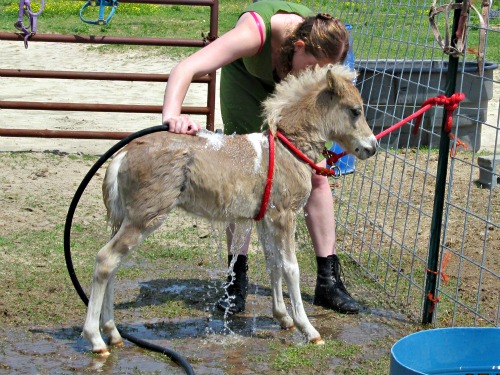
Here's a shot of the body ropes used to tie with. If the rope doesn't slide easily on the halter, we use a snap and ring (pic later) and use a ring under the body for the loop to loosen when they step forward. If his dam shifts to the right, he turns so his head is facing her - he CAN nurse. He also has a small feed bucket all his own in front of him - if he doesn't finish his feed, his dam will be turned loose to do so before the other ponies in the barn pasture are.
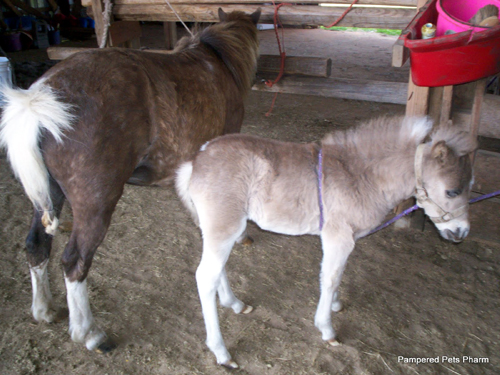
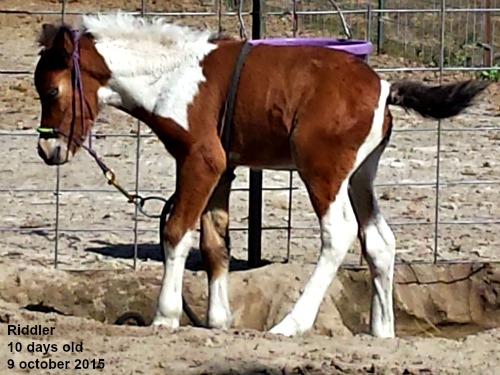
I have lots of foal pics - some were with imprinting techniques but after foaling/dry... The girls were instrumental in handling our babies from day one when they were little and at home. I'm hoping here soon that our granddaughters will become interested...
I have, in the past, actually foaled out some of our mares - even drying the foal's body and clearing "his" nose while hind legs still w/i the mare and she was resting. I've utilized the full Robert Miller Imprint Training (I do have both the book and the video - plus when I was growing up in CO I had the opportunity to visit farms/ranches that used the techniques exclusively for ranch and race horses) and I've also not been there when the foals were born (all of our Shetlands since 2010
Things are a little different now -its harder to do some of the techniques (if I do get down to the ground, can't get up easily and definitely not quickly, LOL). BUT we just change things around. Our foals get handled a little bit every day - they are caught and tied up to eat. sometimes they only wear a halter a few times - but they are still introduced to tying via their collars and a belly rope, moving away from pressure, leading with a "figure 8" around the body and picking up/holding their legs/hooves. They also get introduced to water/hose/clipping (ha - last several years I haven't had clippers operational - so the first clipping will be interesting on some of our coming 4 yr old ponies BUT they are used to having their ears handled, wiped out and trimmed w/ scissors, so after getting used to the sound and vibration - should be fine).
Here's a "figure 8" done with a large/long lead rope and a friends' step grandsons leading the colt. I've actually made a figure 8 with knots and/or clamps - the held at the center.



and here's a psuedo "figure 8" used to tie this filly for a quick bath no halter, no real pulling back (she backs up to the hose now when I fill water tanks!). Classy is about 5-6 weeks old here.

Here's a shot of the body ropes used to tie with. If the rope doesn't slide easily on the halter, we use a snap and ring (pic later) and use a ring under the body for the loop to loosen when they step forward. If his dam shifts to the right, he turns so his head is facing her - he CAN nurse. He also has a small feed bucket all his own in front of him - if he doesn't finish his feed, his dam will be turned loose to do so before the other ponies in the barn pasture are.


I have lots of foal pics - some were with imprinting techniques but after foaling/dry... The girls were instrumental in handling our babies from day one when they were little and at home. I'm hoping here soon that our granddaughters will become interested...
paintponylvr
Well-Known Member
Here are some more shots of foals getting handled -
2012 - Larry w/ "Classy" - hours old. We knew that Bell would be fine w/ this handling, plus I'd already done quite a bit of handling with the foal.
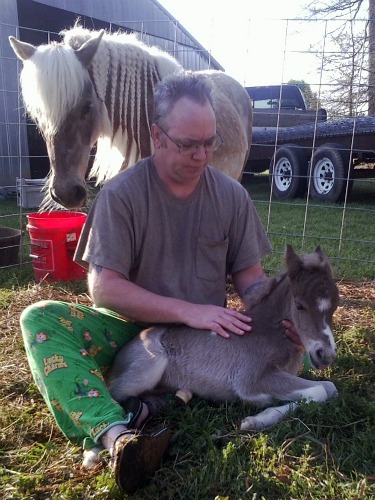
2011 - Sierra giving "Wyndy" a scritching (have lots of pics of other handling - including mouth and hooves/legs).
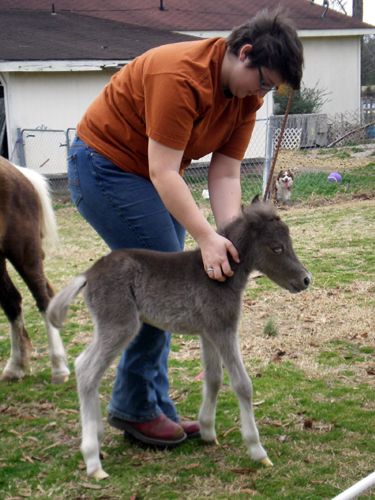
2013 - Baby pets for baby - "Rio" - just hours old with our granddaughter Gracie. "Stuffy" sticks close by, but is GREAT with the kids (our 3 daughters and I raised "Stuffy" in our kitchen for 20 days when she was born in 1997.)
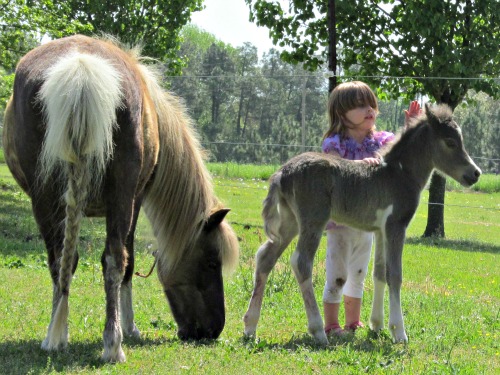
2013 -
"OOOOOO - that tickles!!" Rio is 3 weeks old here and was held till he stopped struggling then turned loose. He actually stayed while loose for a "bum scratch"... That's what you aim for - being able to restrain them w/o struggle and turn them loose w/o them running off.

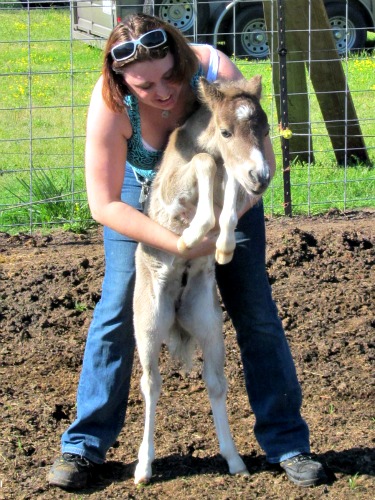
2015 - Baby's first ride?? Farrier, Cat, has just given "Kava" her 2nd hoof trim and before turning her loose (lead/body rope already removed), she is playing with her. GOTTA LOVE a GOOD, FUN, PATIENT farrier!!!
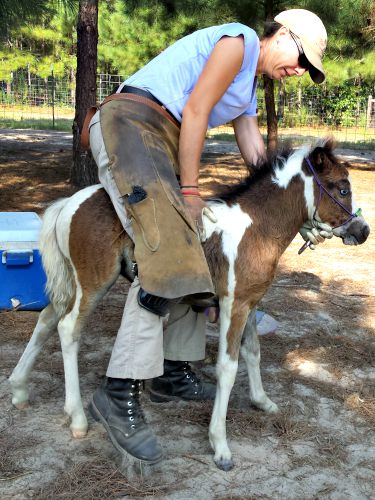
and one more -
2015 - the "all important" discovery of how small/light a new born foal is. This hold can also be used to move the foal to a better spot and a hard to catch mare will usually follow (need to make sure she won't attack you when you turn your back, though). This is Julie picking up "Blitzen" just a couple of hours after birth. Santa and crew delivered "Blitzen" when done w/ her run w/ them - on Dec 26th!!
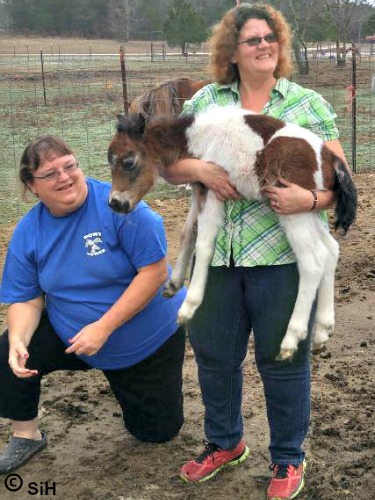
When introducing tying for the first time, I've done the intertube "thing" (tie to it - it stretches the pony steps forward), the body rope (as demo'd in pics above) and a rump rope. I don't, myself, care for the blocker rings that they can pull out of.
A friend of ours had her barn set up so that she had a "tie wall" in almost all of her stalls. The lead rope was run thru a protected hole (lined w/ intertubing or metal flashing) in the wall and tied to a tire or a cinder block outside on the ground. If the horse moved away from the wall or sat back, he lifted the weight. Didn't take long and they'd step forward and very quickly learned to stand quietly. She worked with her own foals (outside training horses were a minimum of 6 months old) in hand first - teaching them to step forward from pressure on the pole (leading) - and they did that well before she tied them for the first time. Like me, she tied her own foals next to it's dam...
2012 - Larry w/ "Classy" - hours old. We knew that Bell would be fine w/ this handling, plus I'd already done quite a bit of handling with the foal.

2011 - Sierra giving "Wyndy" a scritching (have lots of pics of other handling - including mouth and hooves/legs).

2013 - Baby pets for baby - "Rio" - just hours old with our granddaughter Gracie. "Stuffy" sticks close by, but is GREAT with the kids (our 3 daughters and I raised "Stuffy" in our kitchen for 20 days when she was born in 1997.)

2013 -
"OOOOOO - that tickles!!" Rio is 3 weeks old here and was held till he stopped struggling then turned loose. He actually stayed while loose for a "bum scratch"... That's what you aim for - being able to restrain them w/o struggle and turn them loose w/o them running off.

2015 - Baby's first ride?? Farrier, Cat, has just given "Kava" her 2nd hoof trim and before turning her loose (lead/body rope already removed), she is playing with her. GOTTA LOVE a GOOD, FUN, PATIENT farrier!!!

and one more -
2015 - the "all important" discovery of how small/light a new born foal is. This hold can also be used to move the foal to a better spot and a hard to catch mare will usually follow (need to make sure she won't attack you when you turn your back, though). This is Julie picking up "Blitzen" just a couple of hours after birth. Santa and crew delivered "Blitzen" when done w/ her run w/ them - on Dec 26th!!

When introducing tying for the first time, I've done the intertube "thing" (tie to it - it stretches the pony steps forward), the body rope (as demo'd in pics above) and a rump rope. I don't, myself, care for the blocker rings that they can pull out of.
A friend of ours had her barn set up so that she had a "tie wall" in almost all of her stalls. The lead rope was run thru a protected hole (lined w/ intertubing or metal flashing) in the wall and tied to a tire or a cinder block outside on the ground. If the horse moved away from the wall or sat back, he lifted the weight. Didn't take long and they'd step forward and very quickly learned to stand quietly. She worked with her own foals (outside training horses were a minimum of 6 months old) in hand first - teaching them to step forward from pressure on the pole (leading) - and they did that well before she tied them for the first time. Like me, she tied her own foals next to it's dam...
Minimor
Well-Known Member
I never imprint as such--I find many parts of the process to be pointless. our foals get handled from birth; I never halter them before they are a month old--have no need to, if I need to do something with one, holding/restraining the foal without a halter is no problem. After 30 days I will halter and start brief leading sessions in the pen then progress to a bigger area within sight of the mare. with this process I have friendly babies that are no problem when it comes to future training
In all truth though I have bought foals that were never handled prior to coming here--and have had little problem training them. They halter break easily and tame down within a few days--after a month you wouldn't be able to tell which were he bred and which were bought as unhandled weanlings.
The troublesome ones are those that have been handled...or more like MISHANDLED. If they have learned to be afraid of people or if they have been taught bad manners--those are the difficult ones that I prefer to not have
In all truth though I have bought foals that were never handled prior to coming here--and have had little problem training them. They halter break easily and tame down within a few days--after a month you wouldn't be able to tell which were he bred and which were bought as unhandled weanlings.
The troublesome ones are those that have been handled...or more like MISHANDLED. If they have learned to be afraid of people or if they have been taught bad manners--those are the difficult ones that I prefer to not have
JMS Miniatures
Well-Known Member
Imprinting done right can be quite successful but if not done right or well it can cause problems that you will just have to fix. The key is short but frequent lessons and quite honestly with having to work I don't have time for that so I don't mess with it. But I will make time working with them. I don't see any reason why they can't wear a halter right away, just to get the feel of it, don't leave it on. Within a couple of weeks mine should be pretty good at leading. As far as seperating them from momma when working with them they will let you know. I always have mom there when i work with them, especially when they are really young. Probably when they are 3 months they aren't so clingy to momma.
Ellesan
Well-Known Member
- Joined
- Oct 22, 2014
- Messages
- 91
- Reaction score
- 24
Thanks AmySue! I am planning on training this foal to be a therapy horse (like mamma) and want to start early--thanks for your advice! My mare is so sweet but she is maiden so yes, i'll plan for her being good about me touching baby but I will be prepared if she's protective. How soon are you weaning on average?Most of my broodmares are good about letting us handle their foals so we check them over soon after birth, dipping the navel, sometimes towel drying them if necessary. I handle them every day and I find that it really makes a difference. I run my hands all over their body, gently stick my fingers in their ears, look at their teeth, pick up their feet and get them used to grooming and being touched. Haltering and leading depends on the foal, some follow their dam around well while others take off the first chance they get so I do what works best for each individual one. I find it easier for us to teach them the concept of leading by first letting them follow their dam while on the lead, sometimes we will halter the foal, lead momma away then walk the foal on the lead back to her to get them used to leading. The older they get, the farther away we can walk them and the longer time they can spend away from momma. If we do take them away from their dam, say to put them on crossties in the grooming bay or take them over to the milk room for a bath, momma gets extra hay to keep her occupied and we make sure foal nurses before we leave. I personally feel that taking small trips away from mom builds independence and makes weaning easier and less stressful. Now, it is always important to be cautious when getting inbetween a mare and foal, even a friendly mare who usually lets you handle her baby may decide now is not a good time any if you persist, she may bite or kick you, so always be cautious. A few of our broodmares are not incredibly tame, they walk on a lead and load in a trailer and that's about it. They have always been okay (so far) with me dipping navels and examining baby after birth but that is as far as I've pushed it. I usually make my husband go in the stall with me in case the mares decide to get defensive. With these foals, Inlead the dam around letting the foal follow and let them run loose while I graze momma on the lead. I do not turn the untame mares out in big pastures, just paddocks, otherwise I'd never catch them. They get grazed every day, either by me or a student and that is how we slowly tame the foals. In this case, I find that after being totally separate from their dam beginning weanimg, they come around to human contact and pick up leading fairly quickly. I personally find however that these ponies are not as in your pocket friendly as the ones we play with every day from day one. Every foal is different and you will have to adjust accordingly. Obviously the time you have available and your barnyard setup will be a factor too. You do what works best for you and learn as you go. The thing about babies is that you can plan all you want...but sometimes things do not go according to plan and you need to be prepared to improvise and be flexible. Most importantly enjoy it, raising foals is supposed to be fun (hard work) but worth it.
Ellesan
Well-Known Member
- Joined
- Oct 22, 2014
- Messages
- 91
- Reaction score
- 24
Paula, thanks for all the fun photos!!!!!! I'm getting so excited!! I'm gathering the figure 8 and ropes help them learn release of pressure faster than halter? or just watching out for safety not using halters to lead with at first? Sorry the newborn thing is new for me!Here are some more shots of foals getting handled -
2012 - Larry w/ "Classy" - hours old. We knew that Bell would be fine w/ this handling, plus I'd already done quite a bit of handling with the foal.

2011 - Sierra giving "Wyndy" a scritching (have lots of pics of other handling - including mouth and hooves/legs).

2013 - Baby pets for baby - "Rio" - just hours old with our granddaughter Gracie. "Stuffy" sticks close by, but is GREAT with the kids (our 3 daughters and I raised "Stuffy" in our kitchen for 20 days when she was born in 1997.)

2013 -
"OOOOOO - that tickles!!" Rio is 3 weeks old here and was held till he stopped struggling then turned loose. He actually stayed while loose for a "bum scratch"... That's what you aim for - being able to restrain them w/o struggle and turn them loose w/o them running off.

2015 - Baby's first ride?? Farrier, Cat, has just given "Kava" her 2nd hoof trim and before turning her loose (lead/body rope already removed), she is playing with her. GOTTA LOVE a GOOD, FUN, PATIENT farrier!!!

and one more -
2015 - the "all important" discovery of how small/light a new born foal is. This hold can also be used to move the foal to a better spot and a hard to catch mare will usually follow (need to make sure she won't attack you when you turn your back, though). This is Julie picking up "Blitzen" just a couple of hours after birth. Santa and crew delivered "Blitzen" when done w/ her run w/ them - on Dec 26th!!

When introducing tying for the first time, I've done the intertube "thing" (tie to it - it stretches the pony steps forward), the body rope (as demo'd in pics above) and a rump rope. I don't, myself, care for the blocker rings that they can pull out of.
A friend of ours had her barn set up so that she had a "tie wall" in almost all of her stalls. The lead rope was run thru a protected hole (lined w/ intertubing or metal flashing) in the wall and tied to a tire or a cinder block outside on the ground. If the horse moved away from the wall or sat back, he lifted the weight. Didn't take long and they'd step forward and very quickly learned to stand quietly. She worked with her own foals (outside training horses were a minimum of 6 months old) in hand first - teaching them to step forward from pressure on the pole (leading) - and they did that well before she tied them for the first time. Like me, she tied her own foals next to it's dam...
When the foal is born, navel doused, and his selenium shot given, we rub him/her down with a towel from stem to stern (massaging the ears and legs is especially important.....
Then we step back and let mom bond....We try to handle the foal daily, mostly with rubs and scritches. A halter is introduced a few weeks later for just short times and then at some point we attach a lead rope, tie it to mom's halter and walk mom. It's an easy way to teach the foal about leading.... We don't tend to wean until 5 or 6 months....The mare and foal help us decide when they are ready. We used to wean at 4 month like other breeders told us, but over the years have learned that it's easier on both of them to wait. Often by 6 months, the mare is telling her baby, "Enough!".

Then we step back and let mom bond....We try to handle the foal daily, mostly with rubs and scritches. A halter is introduced a few weeks later for just short times and then at some point we attach a lead rope, tie it to mom's halter and walk mom. It's an easy way to teach the foal about leading.... We don't tend to wean until 5 or 6 months....The mare and foal help us decide when they are ready. We used to wean at 4 month like other breeders told us, but over the years have learned that it's easier on both of them to wait. Often by 6 months, the mare is telling her baby, "Enough!".
amysue
Well-Known Member
Most of my foals are weaned around 4-6 months. Every one is different. Some need more time at 4 mos and others are ready to go at 4. Sometimes, momma needs a break, especially if she is bred back for next year so if all is well with the foal, we wean at 4 mos.
Guest
I usually weaned at 4 months, also. But many times the mare had already weaned her foal before I got around to separating them.
As to imprinting, to me, the most important thing is to be there during foaling. That way you are there to be sure all goes well, and to help the little momma if she needs some assistance. Then, depending on the weather, there are times, if it's cold, you need to make sure baby is dried off. After that, I leave the stall, and watch momma for placenta delivery, and to see if she's in pain and needs some Banamine. (I always use the injectable -- but then draw it up in a syringe, take the needle off and squirt it in her mouth. It tastes awful, but works quickly with all the mouth mucous membranes.)
Then, once momma is up, and baby is up, watch for the need to assist baby in standing. Remember, baby doesn't have to stand right away, and it's really fun to watch them work to get on their feet. Watching at this point from outside the stall is good, because many mommas will "talk" to baby to encourage, and it's just plain fun to watch! Remember, baby doesn't have to nurse right away, they have time, so sit back and enjoy watching. Many people make the mistake to get baby to their feet right away to get them to nurse. Much nicer to give baby a little time on its own to unfold their own legs and work to stand. Most will do just fine.
Give momma and baby lots of time with you outside the stall, unless you see something that is very concerning to you. It is very important that momma and baby bond, so resist the impulse for YOU to bond with baby -- at this point, it's all about momma and baby.
You'll be watching for the placenta to pass, for baby to pass his/her meconium, and stand and nurse. Once these things have been accomplished, and baby is up and about (and so is momma, although she may lay down to rest after such a hard workout delivering her little one), you can go get your coffee and enjoy the show!
The next morning, (most of my foals were born at night) when you're feeding momma, take time to move slowly, and meet baby. Most mommas will be happy to eat, and let you meet your new little one. That's the time to get to meet your new little one, moving slowly, and giving "scratches" -- most babies love to get their scratches. At this point, just enjoy, meet with baby several times each day, talking to them, giving scratches, etc.
I always left mommas and babies separated from other mommas and babies for the first 24-48 hours. This time lets baby really bond to momma, but if you have an area they can be out together, that's great. Exercise is wonderful for both, provided the weather is good. For the first 24-48 hours you don't want baby catching a chill, as it's hard for them to regulate their own body temperature, so making sure they are kept warm is very important.
After that, just enjoy. Make sure you spend time with baby every day.
I didn't halter until they were about a month old at least, as there really isn't any reason. Here in Florida, if it was warm, many times I'd clip the babies, and they would usually fall asleep in my lap during clipping. The one thing I did do, is have the farrier (I had a wonderful one) work with baby each and every time he came to the farm. That way, baby got used to having more than me handle them, and my farrier would work with touching the feet, and a little nip or rasp each time. When it came time for a "real" hoof trimming, baby was quite used to my farrier, and we never had a problem.
At 2-3 months, I would work with tying baby for a few minutes each day -- walking away and getting baby used to standing by themselves. At first, you do it around momma, then with momma near, and then by themselves. Only takes a few minutes each day, and babies learn to stand quietly while you brush them, handles them, etc.
Foals are so much fun!!! Each one is different with different personalities, so no "one thing" works on each one. My basic was to do as little as possible the day of birth -- except to be there to assist -- and then watch from a distance so baby could bond.
You're in for so much fun!!
As to imprinting, to me, the most important thing is to be there during foaling. That way you are there to be sure all goes well, and to help the little momma if she needs some assistance. Then, depending on the weather, there are times, if it's cold, you need to make sure baby is dried off. After that, I leave the stall, and watch momma for placenta delivery, and to see if she's in pain and needs some Banamine. (I always use the injectable -- but then draw it up in a syringe, take the needle off and squirt it in her mouth. It tastes awful, but works quickly with all the mouth mucous membranes.)
Then, once momma is up, and baby is up, watch for the need to assist baby in standing. Remember, baby doesn't have to stand right away, and it's really fun to watch them work to get on their feet. Watching at this point from outside the stall is good, because many mommas will "talk" to baby to encourage, and it's just plain fun to watch! Remember, baby doesn't have to nurse right away, they have time, so sit back and enjoy watching. Many people make the mistake to get baby to their feet right away to get them to nurse. Much nicer to give baby a little time on its own to unfold their own legs and work to stand. Most will do just fine.
Give momma and baby lots of time with you outside the stall, unless you see something that is very concerning to you. It is very important that momma and baby bond, so resist the impulse for YOU to bond with baby -- at this point, it's all about momma and baby.
You'll be watching for the placenta to pass, for baby to pass his/her meconium, and stand and nurse. Once these things have been accomplished, and baby is up and about (and so is momma, although she may lay down to rest after such a hard workout delivering her little one), you can go get your coffee and enjoy the show!
The next morning, (most of my foals were born at night) when you're feeding momma, take time to move slowly, and meet baby. Most mommas will be happy to eat, and let you meet your new little one. That's the time to get to meet your new little one, moving slowly, and giving "scratches" -- most babies love to get their scratches. At this point, just enjoy, meet with baby several times each day, talking to them, giving scratches, etc.
I always left mommas and babies separated from other mommas and babies for the first 24-48 hours. This time lets baby really bond to momma, but if you have an area they can be out together, that's great. Exercise is wonderful for both, provided the weather is good. For the first 24-48 hours you don't want baby catching a chill, as it's hard for them to regulate their own body temperature, so making sure they are kept warm is very important.
After that, just enjoy. Make sure you spend time with baby every day.
I didn't halter until they were about a month old at least, as there really isn't any reason. Here in Florida, if it was warm, many times I'd clip the babies, and they would usually fall asleep in my lap during clipping. The one thing I did do, is have the farrier (I had a wonderful one) work with baby each and every time he came to the farm. That way, baby got used to having more than me handle them, and my farrier would work with touching the feet, and a little nip or rasp each time. When it came time for a "real" hoof trimming, baby was quite used to my farrier, and we never had a problem.
At 2-3 months, I would work with tying baby for a few minutes each day -- walking away and getting baby used to standing by themselves. At first, you do it around momma, then with momma near, and then by themselves. Only takes a few minutes each day, and babies learn to stand quietly while you brush them, handles them, etc.
Foals are so much fun!!! Each one is different with different personalities, so no "one thing" works on each one. My basic was to do as little as possible the day of birth -- except to be there to assist -- and then watch from a distance so baby could bond.
You're in for so much fun!!
Ryan Johnson
Well-Known Member
Ive printed it out too. I have a folder with so much wonderful info in it from this forum.

Guest
Thank you both for your kind words! I'm glad to help. If you need something more, just ask!!
Rocklone Miniature Horses
past member -I gotta get a life...
Haaha Diane i love that you say it is more fun to watch them fall over than help them stand. I can't wait to watch that

Similar threads
- Replies
- 3
- Views
- 735
- Replies
- 12
- Views
- 690
- Replies
- 8
- Views
- 483
Latest posts
-
-
-
-
-
Is it possible to get all the loose hair off your shedding mini?
- Latest: Marsha Cassada
-
-
-
-
-
We are finally getting somewhere!
- Latest: Standards Equine


